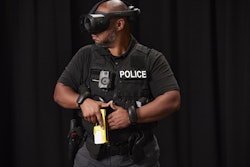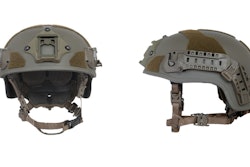In late 2015, Force Science Institute—a research firm focused on exploration and understanding of the science of human performance and behavior during rapidly-unfolding, high-stress events—released the results of a study stating that police officers "on average are only marginally better than lesser-trained shooters in terms of getting rounds on target."
The study examined the shooting performance of 247 volunteers from a college law enforcement program and from two police academies—one in a Northern state and one in the South—who were all tested on ranges with a semi-automatic pistol under similar environmental conditions. The volunteers were divided into three groups—trained "experts" who had completed handgun training in the military or in a formal law enforcement academy firearms course, intermediate shooters who had some previous experience but no academy training, and pure novices, who were minimal familiarity with firearms.
According to a report summary posted to the FSI website, researchers found that "volunteers in the "expert" and "intermediate" groups managed in general to successfully place rounds on the targets at a significantly higher rate than 'novices'" but that "there was no statistically significant difference in accuracy between the intermediate shooters, who had no formal law enforcement handgun training, and the so-called experts, who had completed the full certification requirements of academy sidearm instruction and practice."
Other examinations into "hit rates" for officers shooting under stress—such as the widely cited 2008 study by the RAND Corporation—as well as inquiries into the efficacy of other police tactics such as hands-on arrest-and-control techniques have also shown that success recorded during police training doesn't necessarily result in similar success in real-world application.
This begs the question: "What can be done to improve training, and thus performance?"
Lon Bartel, director of training and curriculum for VirTra, says that the answer lies at least to a certain extent in the concept of transfer—the ability to convert performance in training to actual value in performance of a skill "when we need it."
Illusion of Learning
Bartel says that in training—whether that's in law enforcement or any other discipline requiring mental and physical skills applied in response to randomized input and stimuli—there can be what he calls the "illusion of learning."
"The illusion of learning effect is actually pretty well documented," Bartel explains. "I can actually create this [training] event where it looks like [the student] is getting really, really, really good, but what the research shows is, yeah, you're good in practice, but when it comes to the event itself, you suck."
Bartel presents ideas on improving skill development to law enforcement instructors at venues like the upcoming ILEETA Conference in St. Louis and the recently held Law Enforcement Education Program at SHOT Show in Las Vegas. During those discussions he emphasizes the importance of transfer and offers an acronym—SCORE—he says attendees can implement right away, with no major budgetary constraints/costs that will immediately improve trainee performance.
- Spacing
- Challenge
- Obstacles
- Randomize
- Exceptions/Experience
Let's examine each in turn.
1. Spacing: Training should be spaced out over time—a series of one-hour segments once a week for eight weeks, for example, as opposed to a single eight-hour day every two months.
"If we space our practice out—instead of doing what's called mass practice—that actually gives us better skill development" Bartel says. "A lot of times agencies will saw, 'Every quarter we're going to do eight hours on the range, right? So today's handgun day—let's go do eight hours of training."
Baretl continues, "The research shows—and not questionable, it's clear—instead of eight hours in one day, you'd be better off doing one hour every couple of days. You can literally have less time spent in total in training and get better outcomes when you have a spacing effect."
2. Challenge: Next, every task in training must have a challenge in order for it to create meaningful improvement in performance.
"We don't always provide a challenge to our officers in training. We train the 'lowest common denominator'—we set this minimum standard and that minimum standard becomes the benchmark. Well, not everybody in that class is challenged by that minimum standard. You have a lot of folks that need more than that."
This is called an expertise reversal effect, which refers to the differences in which experts and novices learn. The Oxford Review explains that "novices need step by step instruction, teachers and simple learning tasks with little variability until they know how to think about the topic" but that experts "learn best from having little teaching/instruction and learning tasks that are much more variable."
Bartel summarizes this by saying, "If you don't push your people that are really good, they actually get worse—they backslide. I try to get people to understand it through a fitness analogy. If you come in three days a week on a treadmill at four miles an hour and a five percent incline—and that's what you do every time—you're not getting any better, you're not getting any stronger because you're not challenging it. I need to challenge you.
Bartel adds, "I need to push you, I need to make you do more than what you're used to. Without challenging folks, they don't get better, they don't get stronger, they don't get faster out of the holster."
3. Obstacles: Next in the process is the notion of introducing obstacles—the 'O' in the SCORE acronym—or unexpected events or elements tangential to the stated objective that must be overcome in order to succeed in the drill. Bartel calls this "error induction."
"We have to create problems in training that [trainees] need to overcome, because that's what happens in cop work, right?" Barel says.
For example, for some of the scenarios he runs in a VirTra simulator, he'll place BOSU balls at various places in the training environment on which trainees must stand at points during the exercise.
"Now you've got this unstable platform that you have to overcome," Bartel says. "Could you be bumped? Could you hit gravel? Could you hit wet grass? Could you have an unstable platform in a real environment and have to overcome it? Yes. So I want to create some, some obstacles, whether they're physical or cognitive obstacles that you have to problem solve and figure out."
4. Randomization: The next key element is randomization, because the brain and the body tends to achieve real transfer—usable, permanent knowledge and ability—better through randomized drills than block instruction and strict repetition.
Bartel points to training common on the square range and in the matt room that is frequently conducted counter to this method.
"We love to do block training in law enforcement. We do the same skill over and over and over again. 'From the holster! Draw! Two rounds!'—bang, bang. 'From the holster! Draw! Two rounds!'—bang, bang. It's the same problem to the solution you've already figured out."
He says that by introducing randomization into the set of skills being taught, you impose some cognitive interference, which subsequently demands decision making.
"Now you don't know which [technique or tactic] I'm going to make you use," Bartel says. "I'm going to call it out randomly. Maybe the first time it's two rounds out of the holster. Maybe the next one you have to do is single-round, reload, single-round. Maybe the next one is a transition from target to target. And then I might take you back to, you know, out of the holster two rounds. The skill's not used twice in a row. You do not know what's next."
A more advanced level of randomization is interleaved training, which might combine skills such as defensive tactics with deploying less lethal tools, or transitioning from less-lethal to firearms, or integrating de-escalation tactics with hands-on DT. This of course, requires that the instructor delivering this training have significantly more—and better—instructor development training under their belt.
5. Exceptions & Experiences: Finally, there's the 'E,' which actually stands for two things—exceptions, and experiences.
There are exceptions to every rule, and so too there are exceptions to the above keys. For example, if a person is brand new to learning a skill, it would be imprudent to immediately introduce obstacles or randomization into the training process.
"You can't throw a ton of stuff at [trainees] if they don't even know how to pull the gun out of the holster," Bartel says.
Another example is a breacher getting ready to go hit a door with a ram—this action will benefit from a few good practice swings with the ram before letting loose on the door.
"So prior to an immediate event, there are reasons why we might go repetition over randomization," Bartel says.
"The other 'E' is experiential," Bartel explains. "We want to experience scenario-based situations where you literally have to deal with the concept of reading the environment and applying the skill to it. One of the major differences between your experts and your novices is that experts know where to look and how to interpret the information. But that only comes through experience."
Transfer & Performance
By creating more scenario-based problem-solving training—that is spaced out over time, incorporates challenges and obstacles, randomizes required actions, and allows for exceptions in all of the above—trainers can make great strides in developing skills, abilities, and expertise in their trainees.
Ideally, this is all done in scenario-based, experiential learning—whether it's force-on-force drills, time in some kind of a simulator, doing Red Man drills in a matt room, and the like—in order to truly transfer practice into improved performance.

















